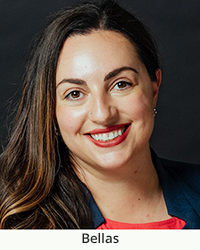Project: Characterization of Biotransport through Engineered Lipedemic Tissues
Evangelia Bellas, PhD
Jennifer Munson, PhD
Principal Investigator: Evangelia Bellas, PhD
Temple University
College of Engineering
Philadelphia, PA
Co-Principal Investigator: Jennifer Munson, PhD
Fralin Biomedical Research Institute at VTC
Virginia Tech
Roanoke, VA
Summary
Lipedema is characterized by the build-up of fat in tissues which have obstructed or poor clearance and drainage. Much work has been done to look at the overall drainage from lipedemic or obese tissues showing that there is reduced transport to draining lymph nodes. However, there is a gap in the knowledge in terms of what is happening within the primary adipose tissues and how the composition, structure, and pathology of these tissues can contribute to limited movement of fatty acids, lipids, fluid, and other biomolecules.
Here we propose to leverage our unique set of expertise in tissue engineered models of adipose tissue (Bellas) and tissue biotransport (Munson) to determine how different normal and pathological states can contribute to limited or altered transport within and through tissues. We hypothesize that lipedemic tissues will have reduced transport, both convective fluid flow and diffusion, through them. This transport will directly correlate with the total transport through vascular networks, contributing to further dysfunction of these conduits.
Background
Lymphatic transport is altered in Lipedema, but lipedemic tissue transport of fluid and biomolecules remains unknown. Transport through the tissue can be obstructed leading to accumulation of water, lipids, and other biomolecules. This interstitial fluid flow (IFF) is particularly critical for transport of large biomolecules. In lymphedema, this is obstructed leading to accumulation of fluid within the interstitial space. In Lipedema, we hypothesize that IFF is aberrant in ways that promote accumulation of lipid molecules. Further, these flows can have effects on cells, triggering migration, proliferation, and gene regulation changes that have implications across disease states. Thus, these flows may yield insight into changes to tissues to define diagnostic criteria and predict therapeutic delivery. The Munson Lab develops novel ways to measure and model this specific interstitial fluid flow and will leverage the BellasFATLab’s adipose tissue engineered models along with these measurements to analyze changes to IFF under multiple conditions.
Methodology
First, we will develop 3 engineered models of hypoxic, fibrotic, and normal states using patient-derived adipose stem cells (ASCs) from normal and lipedemic patients (n=3 patients/condition, total 6 patients). Constructs will be maintained +/- estrogen, a modulator of Lipedema. We will quantify AT function and morphological features and benchmark to ex vivo human lipedemic adipose tissues (AT). We will examine diffusion/convection of FITC-Dextran and fluorophore-labeled fatty acid with each condition to calculate diffusivity, permeability, and superficial velocity. Then assess overall transport in 3D using MRI using methods. The change in contrast agent will be used to simultaneously solve for convection and diffusion, the 2 primary forces of biomolecules movement through tissues. We will then solve for diffusion and velocity and reconstruct flow vector fields.
Next, we will incorporate vascular cells and networks to determine their effects on drainage and interstitial fluid flow. First, we will determine changes to transport parameters with addition of an endothelial cell monolayer to our simple tissue culture insert AT model. Then apply this knowledge to the AT construct and determine transport and diffusion properties. We will create a perfusable vascular network to deliver contrast agents (MRI) or fluorophores (microscopy) to examine vessel permeability, interstitial fluid flow, and diffusion within the engineered AT. We will again apply fibrotic, hypoxic, normal, and estrogen-treated models to these custom Lipedema-on-chip platform systems.
Finally, we will test 2 potential therapies, compression therapy and VEGF, on vascular permeability and transport, in Lipedema-on-a-chip and ex vivo AT. Through controlled infusion of contrast at rates similar to those applied/measured and MRI, we will reconstruct diffusion and velocity fields and characterize the tissue organization for vascular structures, adipocyte morphology, macrophage polarization and fibrosis. With prior aims, we can further assess our models by comparing parameters and begin to apply data to create a computational model of AT transport.
Expected outcomes
A validated engineered adipose tissue model of Lipedema. A set of basic transport parameters within adipose tissues will be developed for the first time using these types of advanced models. Patient variability and effects of estrogen will also be determined.
Successful completion of Aim 2 will provide critical characterization of blood and lymphatic vascular transport parameters in engineered adipose tissue models of Lipedema. We hypothesize that interstitial fluid flow will be reduced as the vessels serve as a barrier to fluid movement through the tissue but that with Lipedema-derived cells we will see aberrant or irregular transport patterns. We also hypothesize, that in line with literature, lymphatics will uptake lipids and reduce their transport across the barriers. In the vascularized model, we hypothesize that interstitial fluid flow will be directed towards and along these structures, but that this will be obstructed in Lipedema-derived tissues.
Successful completion of Aim 3 will demonstrate the potential of 2 clinical interventions (compression and VEGF therapies) to alter outcomes during progression. Further validation of our model compared to patients will also be completed.
Practical implementations of results
This unique approach provides clinically relevant and quantifiable parameters to characterizing lipedemic tissue. Further, these models set up the potential for patient-specific models for therapeutic testing as both endothelial cells and adipocytes (derived from adipose tissue stem cells, ASCs) can be isolated from small adipose tissue biopsies. This is the only model which accounts for several of the important factors in lipedemic tissues (microenvironment, vascularization, fibrosis, biotransport). Further, our patient population is diverse, where most patients are African American and Hispanic, and thus we hope to contribute to the field by accounting for diverse patient populations.
Our Research Grantees by: Topic | Recent Projects | Past Projects
LF33_21



